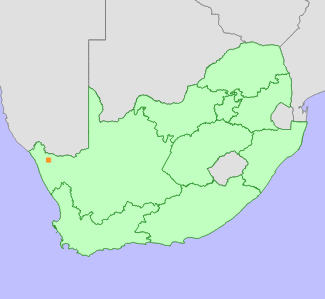|
Scientific Name | Conophytum phoeniceum S.A.Hammer |
Higher Classification | Dicotyledons |
Family | AIZOACEAE |
National Status |
Status and Criteria | Critically Endangered A2ac |
Assessment Date | 2020/02/06 |
Assessor(s) | A.J. Young |
Justification | Field observations indicate a significant population reduction within three generations. Although the population data is very uncertain, it is suspected that it has declined by around 80%. Recent attempts to locate this species in the wild have failed. The reasons for the population reduction are not understood but are suspected to be related to habitat degradation. It is not known whether threats have ceased, and the current population trend is not known. The last field observations were of extremely small, isolated groups of plants occurring within a few square meters or less. It is therefore possible that it may be overlooked, and it is not suspected to be extinct, but further field surveys, particularly in years of good rainfall are needed. Given the substantial declines experienced this species is listed as Critically Endangered under criterion A. |
Distribution |
Endemism | South African endemic |
Provincial distribution | Northern Cape |
Range | This species occurs in the Richtersveld near Umdaus, north of Steinkopf. |
Habitat and Ecology |
Major system | Terrestrial |
Major habitats | Umdaus Mountains Succulent Shrubland |
Description | Plants grow in quartz flats. |
Threats |
| Part of the population was lost to road construction in the 1990s (Hammer 2002), and there has been further sporadic impacts from mining exploration on the habitat. This however does not explain the extensive population decline observed over the past 20-25 years which is likely due to degradation and trampling of quartz flats by livestock. The area is part of communally owned rangelands. There is a potential threat from illegal collection as the taxon is popular with growers. However the cryptic nature of the plants affords it substantial protection. |
Population |
This species is known from a single subpopulation that was estimated to consist of several thousand plants in the 1990s (Hammer 2002). It has however not been observed in its habitat for several years, despite many field visits to the immediate area. The population appears to have declined significantly, but the reasons are not known. The last two observations of this species in the wild were of extremely small, localized clumps of fewer than 50 individuals. It is possible that a few other, overlooked small clumps of plants exist. It is therefore difficult to determine the size of the remaining wild population, which is possibly very small, perhaps less than 500 mature individuals. Due to the uncertainty around population size estimates, it is difficult to infer the extent of the population reduction. It is suspected to be at least 50%, but is probably as much as 80-90%. C. phoenicium is a relatively short-lived species (generation length of only a few years), but the decline occurred over a very short time frame, within three generations. The current population trend is unknown.
|
Population trend | Unknown |
Assessment History |
Taxon assessed |
Status and Criteria |
Citation/Red List version | | Conophytum phoenicium S.A.Hammer | CR A2ac | 2017.1 | | Conophytum phoenicium S.A.Hammer | VU D2 | Raimondo et al. (2009) | | Conophytum phoenicium S.A.Hammer | VU D2 | Victor (2002) | | Conophytum phoenicium S.A.Hammer | Rare | Hilton-Taylor (1996) | |
Bibliography |
Hammer, S. 2002. Dumpling and his wife: New view of the genus Conophytum. EAE Creative Colour, Norwich.
Hammer, S.A. 1993. The genus Conophytum: A conograph. Succulent Plant Publications, Pretoria.
|
Citation |
| Young, A.J. 2020. Conophytum phoeniceum S.A.Hammer. National Assessment: Red List of South African Plants version 2024.1. Accessed on 2025/12/30 |
 Comment on this assessment
Comment on this assessment

